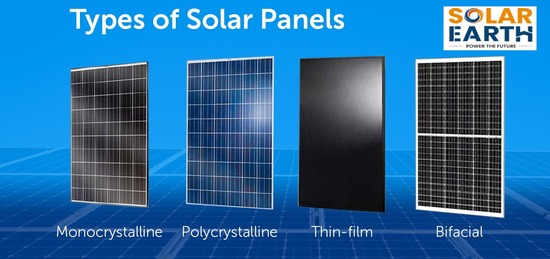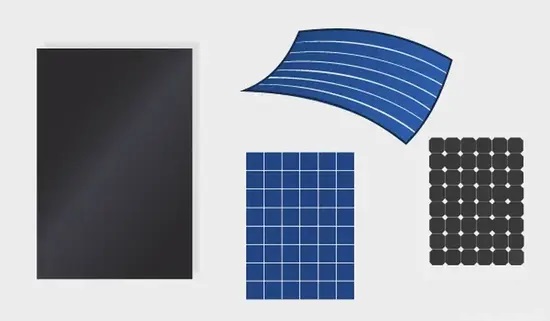Solar energy has grown rapidly in India, driven by government incentives, falling module prices, and increasing environmental awareness. But one thing that often confuses homeowners, businesses, and policy-makers is which kind of solar panel to choose.
One of the most common questions our customers ask when planning a solar installation is, Which type of solar panel is best for home use? And it’s a valid concern. With so many different types of solar panels available in India today, making the right choice can feel confusing.
In the past, traditional first-generation panels like monocrystalline and polycrystalline were the go-to options for most homeowners. But as solar technology has evolved, the market has expanded to include more advanced and efficient options such as bifacial and PERC panels.
These newer models are designed to deliver better performance, greater efficiency, and improved value for modern homes. There is no one-size-fits-all; each type has its strengths and limitations, depending on space, budget, location, and performance requirements.
Here are the main types of solar panels you’ll find in India (and globally), how they differ, and when each is appropriate.
Types of Solar Panels in India
By March 10, 2025, the government had effectively solarized over 10+ lakh homes across India under its subsidy scheme. A major reason behind this inspiring achievement is the swift advancement in solar technology.

Earlier, the first-generation solar panels weren’t very effectual at converting sunlight into electricity, which affected their overall return on investment.
But today, with modern innovations like bifacial solar panels and mono-PERC half-cut bifacial panels, competence levels have soared. These new panels produce more power from the same amount of sunlight, making solar energy not just a cost-saving choice but a smart long-term investment.
Now, let’s take a closer look at the various types of solar panels available in India and find out which one is the best fit for your home.
-
Monocrystalline Solar Panels
What are they?
These panels are made from a single, pure crystal of silicon. The silicon is grown into a large cylindrical ingot, sliced into wafers, and then formed into solar cells. These cells have a uniform, often dark/black appearance.
Efficiency & Performance:
- Typically among the highest efficiencies for commercially available panels, around 18%–22%, sometimes more with advanced variants.
- Better at handling low light and somewhat more tolerant of partial shading. Also, better heat performance compared to many lower-grade panels.
Lifespan:
Long – about 25 to 30 years or more in good condition.
Cost & Drawbacks:
- More expensive upfront per watt compared to other types.
- Production of pure silicon ingots involves more processing, more waste, more energy.
- If roof space is sufficient, the higher cost may be justifiable by greater power per square meter.
Best suited for:
- Homes or buildings with limited rooftop space (you want maximum output per sq ft)
- Places with intermittent sunlight, shading, or non-ideal orientations
- Those willing to invest more upfront for better long-term performance and savings
-
Polycrystalline (Multicrystalline) Solar Panels
What are they?
These are made by melting multiple fragments/crystals of silicon together rather than growing a single crystal. You’ll often see a blue, speckled look in these panels, not as uniformly dark as monocrystalline.
Efficiency & Performance:
- Lower than monocrystalline: commonly in the 15%–17% range.
- More sensitive to heat (efficiency drops more under higher temperatures).
Lifespan:
20-25 years typically.
Cost & Drawbacks:
- Lower cost per watt than monocrystalline. Easier, less wasteful production.
- Need more area to get the same power. If roof or land is not a constraint, this may not matter much.
- Aesthetic appeal is somewhat less (color, uniformity) compared to mono panels. Some people prefer uniform dark panels for looks.
Best suited for:
- Installations with large space (roofs with low cost per sq ft, farms, warehouses)
- Budget-sensitive users where initial investment must be lower
- Where maximum efficiency per sq ft is not the only concern
-
Thin-Film Solar Panels
What are they?
Instead of thick, crystalline silicon wafers, these panels use very thin layers of photovoltaic materials deposited onto a substrate (which could be glass, plastic, metal). Common materials include amorphous silicon (a-Si), cadmium telluride (CdTe), copper indium gallium selenide (CIGS), etc.
Efficiency & Performance:
- Lower efficiency: often in the 10%-12% range (some types may be higher), lower than crystalline silicon modules.
- However, thin-film panels often have better performance in diffused light (cloudy, overcast), lower sensitivity to shading, and sometimes better temperature coefficient (they lose less performance at higher temperatures).
Lifespan:
Tends to be shorter – about 10-20 years, depending on material and build quality.
Cost & Drawbacks:
- Lower cost in terms of material and manufacturing for some types. But because of lower efficiency, you may need more area, more mounting structure, more supporting infrastructure, which adds cost.
- Durability and degradation (how performance drops over time) may not match top-quality crystalline panels.
- Not suitable if the roof/space is limited or you need high output from a small area.
Best suited for:
- Large-scale utility or solar farms where space is abundant
- Applications needing flexibility, lightness, or integration into building facades, curved surfaces, portable uses, etc.
- Places with diffused sunlight or frequent overcast where thin-film’s better diffuse performance helps
-
PERC, Bifacial, and Advanced Variants
In addition to the “basic” three, there are more advanced panels or cell technologies that enhance performance or serve specific contexts. Here are a few:
- PERC (Passivated Emitter and Rear Cell): A layer is added to the rear side of a monocrystalline cell to reflect unused light back into the cell, improving efficiency. These often push performance a bit higher, sometimes above standard mono panels.
- Bifacial Panels: These generate power from both front and back sides. If there is a reflective surface beneath (white roof, ground, water, etc.), the back side can contribute significant additional generation. Useful in some commercial and utility-scale setups.
- Other Emerging/Third-Generation Types: These include materials like perovskites, organic PV, etc. These are still generally in development or early roll-outs globally, not yet widespread in Indian residential or commercial mainstream installations.
Comparison Table
| Panel Type | Efficiency (Typical) | Lifespan | Cost per Watt (Approx) | Appearance | Best Use Case |
| Monocrystalline | ~18-22% (may go higher) | ~25-30 years | High | Uniform black, neat edges | Limited space, rooftop, high performance, premium installs |
| Polycrystalline | ~15-17% | ~20-25 years | Moderate | Blueish, speckled, square edges | Larger roofs, lower cost, less premium aesthetics |
| Thin-Film (a-Si, CdTe, CIGS) | ~10-12% (some better) | ~10-20 years | Lower material cost, but more area cost | Various, sometimes flexible or lightweight | Large area, commercial farms, BIPV, curved surfaces, off-grid, special cases |
| PERC / Advanced Mono | Slightly above Mono standard | Similar or slightly better | Premium | Usually similar to mono, maybe with design tweaks | Hot climates, maximizing output, limited space |
| Bifacial | Front + back: possibly 10-25% more output (depending on setup) | ~25-30 years | Premium | Transparent / rear usable, depends on mounting | Utility scale, reflective ground/roofs, places where both sides can be utilized |
(Note: Costs per watt depend heavily on global supply chain, subsidies, local transportation and installation, module make & brand, quality, etc. The ranges can vary widely.)
Key Factors in the Indian Context
When deciding which type of solar panel to use in India, several local considerations matter:
- Climate & sunlight
India has high solar insolation in many regions, but also high temperatures, dust/humidity, and monsoon seasons. Panels with good performance under heat and easy maintenance (dust cleaning, etc.) tend to do better. Monocrystalline (especially with PERC) tends to resist heat better; thin-film sometimes helps in diffused light. - Space constraints
Urban homes often have limited rooftop area. To maximize power per square metre, higher-efficiency panels like mono or PERC are better. If space is abundant, polycrystalline or thin-film may suffice. - Budget and Payback
Higher efficiency + premium panels cost more initially, but may deliver better returns over time (higher output, lower depreciation). However, if the budget is tight, a lower-cost panel may still be acceptable, especially if you have subsidies or grants. Government schemes like the National Rooftop Solar Portal may help. - Durability, Warranty & Degradation
Modules degrade over time. Quality makes a big difference. For example, how performance drops year by year, how well the module handles high temperature, humidity, and potential mechanical stresses (wind/dust/hail). A good warranty (performance + product) is important. - Installation and Maintenance
Ease of installation, weight of panels, support infrastructure, cleaning, accessibility. Some thin-film panels are lighter and more flexible; others are more delicate. Local service support by manufacturers or installers matters a lot. - Government policies and incentives
Subsidies, import duties or incentives on solar modules, policy for net metering, and local regulations. In some states, subsidies are higher for certain technologies. Also, considerations like customs/import cost of panels, local manufacturing (Make in India), can affect pricing and availability.
Which Solar Panel Type is Best for Whom?

Here are some scenarios, with suggestions:
- Small rooftop in a city (e.g. Mumbai, Delhi)
Limited area, high shading, desire to maximize output → Go for monocrystalline or mono-PERC panels. The extra cost per watt may be worth it. - Large roof / warehouse / farm
Space is less of a constraint → Polycrystalline or even thin-film could be more cost-effective. If you can install bifacial panels or use reflective surfaces, that could further improve yield. - Commercial/industrial installations
Want durability, good warranties, maximum output, and decent return → Often premium mono or advanced variants like PERC or bifacial. - Building integrated or special surfaces (facades, curved roofs, etc.)
Thin-film or flexible modules make sense; even some newer technologies that are lighter, flexible, or semi-transparent. - Off-grid or portable setups
Lower-weight, lower-cost panels like thin-film or simpler polycrystalline modules are often used for solar lights, rural electrification kits, etc.
Example Cost / Efficiency Ranges in India
To give some real numbers (approximate, and for reference; actual costs vary a lot by location, brand, import costs, tariffs):
- Monocrystalline panels: ₹30-₹38 per Watt-peak (Wp) for good quality modules.
- Polycrystalline: ₹25-₹32 per Wp.
- Thin-film: about ₹22-₹28 per Wp (but more area required for the same output).
- Advanced panels (PERC, bifacial) will cost more, potentially in the higher end of mono panels or above, depending on brand.
Challenges & What to Watch Out For
- Performance drop (degradation) over the years, especially under Indian conditions (dust, high temperature, humidity)
- Authenticity / quality of modules: Some imported panels may not meet claimed specs or warranties
- Proper installation, tilt, orientation – even a good panel will underperform badly if installed incorrectly or shaded
- Maintenance: dust accumulation, soiling, cleaning, checking electrical connections etc.
- Ensuring inverter, mounting structures, wiring, all of these matter and must match the panel’s potential.
Conclusion
There is no perfect solar panel type that fits every situation. The choice depends on balancing:
- Efficiency vs cost
- Space available
- Climate / sunlight & weather patterns
- Long-term vs short-term returns
- Aesthetics and structure
In many cases, monocrystalline or mono-PERC panels are a safe premium choice for residential or mixed-use in India. If you have more space and are more cost-sensitive, polycrystalline may do well. For special use-cases (lightweight, portable, facades, etc.), thin-film or flexible modules have their place. Advanced variants (bifacial, etc.) are options where site conditions allow them to shine.



